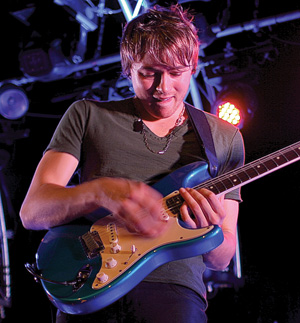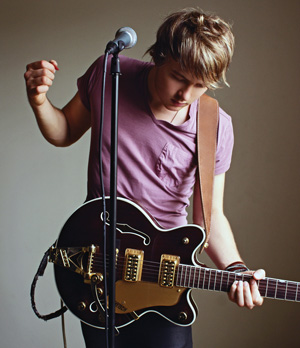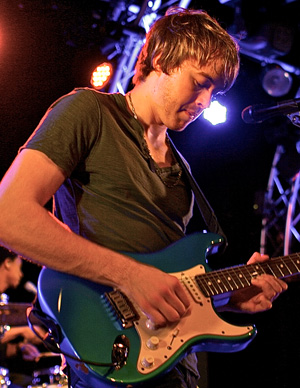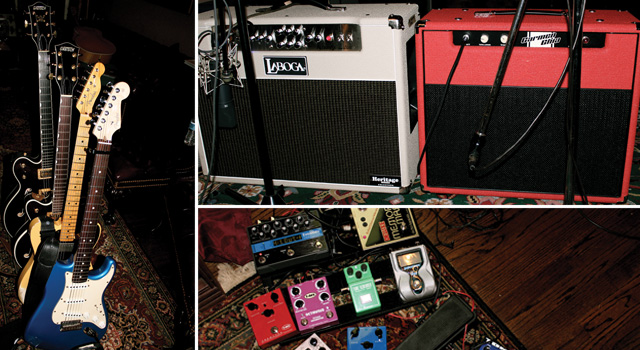
|
本帖*后由 Stone654 于 2016-12-29 13:06 编辑 访谈:Joe Robinson Andy Ellis,翻译Stone654 
摄影:Andy Ellis 有这样一位年轻的吉他演奏家,在他生涯的早期就己经万众瞩目,经过时间的历练后逐渐成熟并被冠以“天才”的标签。Joe Robinson就是这样的旷世奇才:21岁时他就已经成名快10年了,开始在澳大利亚众人皆知,后来名声外传到欧陆和英国,*后又到了美国。 对那些Robinson的乐迷来说,这个曾经的毛头小子夺得电视才艺大赛的冠军的事迹早已是陈年往事。对我们杂志的读者而言,更感兴趣的应该是他蒙受Tommy Emmanuel的指导多年,经常被带去同台演出。虽然琴龄只有10年,但他已经是在世界各地到处举办演奏会的行家里手了。他成功的秘诀是每天早晨四点起床,练习四个小时之后再去上学,放学回家继续再练四个小时的琴。谈到努力程度Robinson可一点不输给任何人,这近乎疯狂般的执着令他在同龄人还沉迷于漫画和游戏的时候就声名鹊起。 Joe回忆说:“在我十二岁的时候,我开始和一位叫做Texas Rose的澳洲乡村音乐人进行巡演。他借给我一把电吉他,我之前从来没有属于自己的电吉他。那是一把Yamaha SG—700,我借了两年。” Robinson 2009年在美国发行的指弹专辑Time Jumpin’迅速为他赢得了乡村指弹群体的尊敬。现在他每年都会在一年一度的向Chet Atkins致敬的演出上和一些顶级的指弹演奏家比如Tommy Emmanuel, Thom Bresh, Martin Taylor, Doyle Dykes, Muriel Anderson还有Steve Wariner一同演奏。Time Jumpin’这张专辑是由Brad Paisley的出品人Frank Rogers出品的,他知道什么样的人能红。 Robinson的新专辑Let Me Introduce You同样也是由Rogers出品,温文尔雅的他把自己塑造成了一个创作型歌手的形象。专辑有着鲜明的狂野的特色(指弹和歌曲都有),流行歌曲的唱腔可能会让指弹乐迷们一时间摸不到头脑。 “我之前从来没录过电吉他的商业专辑“,他说。”我从唱片的录制过程中学到了很多,现在我在录音棚和很多一线音乐人以及顶尖的出品人和工程师合作,感觉就像大学刚毕业一样充实。“ 我们*近在他经纪人位于纳什维尔的办公室采访了Robinson,和他聊了一会儿在录音棚中的收获以及他*近的灵感、使用的设备和接下来要做的打算。 Q1:Let Me Introduce You这张专辑你是在哪里录制的?大概花了多长时间? A1:我们从去年三月开始一直录到十月结束,时间这么长的原因是我们是分成一段一段录制的。先是花了一个周末把鼓和贝斯录好,地点是在纳什维尔郊外的一个叫The Castle的录音棚。然后我就去巡演了,回来后我分别在几个不同的棚子里把电吉他录好。出品人Frank Rogers此时另有安排,他出差了一个月。我们零零散散地工作直到把所有的东西都录好。 Q2:节奏吉他是和鼓还有贝斯一起做的后期吗? A2:为了获得*佳的效果,我们分成三轨进行录制。进录音棚之前我们花了三天进行彩排,因为我想在录音时表现得像合作已久的乐队一样。我尽量避免在录音棚里排练曲子。 Q3:鼓手Keith Carlock和贝斯手Michael Rhodes也来了,阵容可谓豪华。你们的合作是怎么开始的? A3:多年以来我一直是Keith的乐迷,我喜欢他所有的和Wayne Krantz,Oz Noy还有55 Bar乐队在纽约录制的作品。让他来给我的专辑伴奏一直是我梦寐以求的事,所以见面时他答应合作令我十分激动。我知道他之前和Michael合作,所以我把他邀请过来负责贝斯,对此他兴致很高。站在边上欣赏他们的演奏对我来说就是美梦成真。 Q4:和这些人一起录音你紧张吗?他们可是和James Taylor, Steely Dan, Sting, Vince Gill, John Mayer, 以及Keith Urban这些大牌一起合作过的。 A4:并不,对我来说反而非常的有趣,唯一需要担心的就是别把录音顺序弄错。绝大多数曲目应有的演出效果我已胸有成竹,所以让Michael和Keith和我的想法一致是非常重要的一件事,否则录出来的东西就会完全偏离我想要的结果。和这些老练的音乐人合作十分令人省心,你提出的每一个细小要求他们都会加以配合。彩排的时候我把曲目单给了他们,到录音的时候我们对应该有的录音效果已经很有把握了。 Q5:对于你提出的要求能给我们一个具体的例子吗? A5:有一个非常具体的例子,比如我知道自己想要的镲片音色是什么样的。我自己经常写一些贝斯乐句,所以对这个也很熟悉。有一回我给Michael提了一点建议,起初他仿佛觉得我在逗他笑,但在Lethal Injection这个曲子中,主要部分不仅是和弦,所以我要演奏贝斯声部。对于我的大多数想法他是欣赏的,但还有一些需要润色加工一下,注入生命活力,而不仅仅是机械般地演奏。 Q6:录制这张专辑给你的*大挑战是什么? A6:对我来说,边弹边唱是一个不小的挑战。我想让歌曲达到一种指弹演奏给歌手伴奏的效果,所以在精准演奏的同时我不能在演唱上出错。 我把James Taylor作为榜样,我喜欢他边弹边唱的风格。他吉他弹得棒,唱的也棒,两者相得益彰。在歌曲中我想把吉他当成一个独立的元素,于是我应用了一些指弹演奏中常见的对位技巧处理人声并平衡自己与其他演奏家的演奏。这种演奏风格*大的特点是变化的和声结构,在一个行进的贝斯声部上叠加一段旋律。我*大的挑战是将人声融入这种演奏之中。 
Gretsch公司的Country Gentleman是Robinson的主力琴之一,但是他在Introduce这张专辑中主要使用1960年款Gibson ES-335吉他。 摄影:Ethan James Q7:你在家里会录制小样吗? A7:指弹曲目和歌曲我都会录制小样。我会用木吉他将所有的作品都弹奏一遍,即使正常应该是用电吉他去演奏的一些曲子。我想用这种方法看看*原始的效果是什么样的,为了确定*合适的曲目我录制了大量的小样。准备花了一个月,为的是不再彩排的时候大脑一片空白。我专心于小样的录音,确认歌曲吐字清楚不跑调,能正确表达我的想法。 说实话我有点紧张,之前我并没录过歌曲的专辑。虽然我写过很多首歌,但是并没有一首是专门为我自己做的。所以当我打算和乐队一起录制歌曲的专辑时,我尽可能多地汲取这一领域的知识。我和Music Row(这是纳什维尔第16和17大街上音乐出版商的传统聚集地)的那些人一起作词作曲了一段时间,连续六周每周五个工作日地工作,争取每天都写出一首新歌。每一周我都对写歌作曲有了更深刻的体会,写出来的作品也越来越棒。和他们在一起很有意思,有些词曲作家真的是天才。 Q8:你从这次作曲特训中学到了什么呢? A8:作为一名音乐人有件事值得你去警惕:大多数歌曲你拿过来基本都能弹,怎么弹都说得过去。和其他音乐人合作时,我会弹奏一段很酷的吉他乐句,得到他们的欣赏。这样写出的作品往往很工整,但却是靠一段吉他乐句撑起来的,所以我尽量避免这种过度依赖的发生。 有时候我在Music Row排练现场别人会问我:“你的音乐是什么体裁的呢?”每当这时候我都有点茫然:我又不是在给乡村或流行音乐电台写歌,我只是在创作一些我心中的好东西。 Q9:那你给自己的音乐是怎么定位的呢? A9:我欣赏那些乐感与众不同的人,这令我感到振奋。看美国好声音的时候,有些歌手唱的真不错,但声音太像了。摇滚布鲁斯圈子也一样,弹出来的东西都大同小异。我喜欢那些充分运用自己的天赋技巧创作新颖有趣作品的音乐人,这是我喜欢和键盘手合作的主要原因:他们总是有一些吉他手想不到的和声上的想法。我尽可能在吉他作品中融入键盘乐器。 Q10:Introduce专辑上的歌曲都是在这一时期创作完成的吗? A10:大多数都是在录音之前几个月写成的,指弹作品历时则稍微久一点。Lethal Injection写了已经有一年了,Uli’s Jump是我17岁时写的,这是专辑上*老的作品。 Q11:Uli’ Jump这个曲子让我想起了Jimmy Bryant。你深入了解过他吗? A11:是的,他真是太赞了!你听过他和木吉他演奏家Speedy West合作的专辑吗?我能默弹里面的一些曲子,以前我和悉尼的一个朋友合作过里面的所有曲目。 Uli’s Jump是我和Pat Bergeson一起写成的,他是我喜欢的来自纳什维尔的一名吉他演奏家。当时我和他正在德国办一场演奏会,身边恰巧有一个叫Uli的人,我和Pat就演奏了这个曲子。我尽我所能从Pat那里汲取有关吉他的知识。 Q12:这张专辑中你都用了什么设备?你从之前的经历中学到了什么有关录音的知识呢? A12:我很幸运,我在Frank的家庭录音棚里录了很多电吉他的乐段,他有非常棒的电吉他收藏。设备很重要,因为在混音中每一把吉他都有特定的声像,如果你选对吉他效果会很不一样。 至于Barely Hanging On这首歌,我从2003年就开始用一把Strat了,那是我买的第一把电琴。小时候我把琴颈螺母拧滑丝了,*近索性就把琴颈换了。上面的拾音器是由Adelaide的Mick Briendey手工缠绕而成的。他的东西很不错,价格也合理,很多澳洲的吉他手都在用。我的两把Strat和一把Tele用的就是这个拾音器。 我们没太依靠我的那把Gretsch Country Gentleman,这是我的主力琴之一,我仅在Adelaide和One Heart at a Time这两首曲子中使用了它。大多数时间我都在用Frank的一把 1960年款Gibson ES-335,再接到Laboga Alligator 30上面。这是一款波兰的class A 30瓦2x12一体箱。我很喜欢它的音色,听起来有点像Vox AC30,但是要细腻很多。 Q13:你是怎么发现Laboga这款音箱的? A13:这个牌子在美国大概只有五只, Tommy Emmanuel在纳什维尔就有一只。我借用过一次,然后认识被彻底颠覆了。有些音箱和我的Gretsch相性不合,我喜欢AC30和Gretsch的搭配,但Fender的音箱就不太协调。当我把Gretsch接入Laboga演奏的时候,那感觉就像在天堂。 我和Laboga的人联系让他们寄给我一只,经过国际航运和海关等艰难险阻之后,我终于拿到了一只。这张专辑中我使用了一只Dr.Z Carmen Ghia 1x12一体箱去搭配它使用,效果很棒。 Q14:你同时录制两个音箱的音轨吗? A14:是的,毕竟只录一个你会永远错失机会,于是信号链路变得十分紧凑。中间我接了一个复古电子管失真单块和一个T-Rex Octavius单块。至于非失真类型的效果,比如延迟和混响,我喜欢在后期混音的时候用插件加在干音上。 Q15:原声吉他呢? A15:一些歌曲中我使用Frank的Gibson J-45进行伴奏。除此之外我还使用一把Everett吉他,这是一款小箱体的琴,当然还有Maton。我给他们上了粗得难以置信弦,并用麦克贴近录音。在特定的音轨上我们使用铝带话筒,并且每一首歌我们都使用不同的吉他和麦克组合。 
2012年2月22日,Robinson在纳什维尔的12&Porter举办的Let Me Introduce You发布会上弹奏他的定制款Strat吉他。 摄影:Andy Ellis Q16:你说“粗得难以置信的弦”是什么意思? A16:在木吉他上我用.012规格的Elixir 80/20黄铜琴弦,但一弦换成.016粗细的。在一些歌曲中,比如Hurricane,我怎么弹都觉得差点意思,于是我就换上了一套.013的琴弦,并将一弦换成了.018规格。这首歌是用一把Maton录制的,变调夹夹一品。弹完之后我整个手都酸了!后来这把琴在飞机上被搞坏了,可能是暴力托运,也可能是因为琴弦太粗张力太大。 Q17:你在电吉他上也用很粗的琴弦吗? A17:在Gretsch上,我通常使用.011-.049规格的套装,然后一弦换成.012或者.014。我的Strat用.010套装,一弦换成.012,对我来说这样弹起来*舒服。这些弦都是Elixir的Nanoweb系列产品。 Q18:你在台上都使用什么设备? A18:就木吉他来说,我用一把Maton公司的吉他。它有压条麦克双拾音,并配有琴载前级。至于电吉他,巡演时我经常带一把Strat和一把Gretsch。 当我想自备音箱的时候,第一选择是Laboga,但通常我还会带一个AER Compat 60原声音箱。对我来说舞台上的返听音箱听起来总是很怪,AER前级和音箱的组合听起来很惊艳。我还会带一块Peterson StroboStomp2 调音单块。它有一个DI输出,当和别人合奏的时候,我会拿它当我的DI输出。差不多就这些了。 Q19:你的现场表演以劲爆著称,你是怎样发展出这种舞台风格的呢? A19:当我踏上舞台,我的感觉和拳击手踏上擂台是一样的。我尽可能将我的演出搞得像是要用吉他拍你的脸一样(笑)。我试图怀着一种特别的自信,用一种特别的态度去触弦,这很难解释。如果非要比喻一下的话,就好像是要将你的音符钉进现场后排的墙上一样。 所有对我有影响的让我肃然起敬的演奏家都有上述的特质。听听Stevie Wonder的口琴演奏,那感觉就像是别人在你的眼眶上来上一拳那么有力。低眉信手续续弹的那种吉他手对我并没有多大吸引力,毕竟我自己也不是这种演奏风格。当然我佩服那些民谣歌手,我民谣弹得很烂,但我会尽我所能去演奏。 Q20:你还记得*开始有这种想法是在什么时候么? A20:当然。小时候我在街头酒吧演出时需要买一些自己灌的唱片来赚点钱,所以我尽可能去炫技,大量使用速弹技巧以期给观众*深的印象。这很有效,唱片销量一直不错。这些经历一直影响着我,现在我演奏时也会倾向于让全场沸腾起来。 Q21:你提到了Stevie Wonder,还有谁在音乐上给了你启发? A21:我*近听了很多鲍勃迪伦的歌,主要是听歌词。我也喜欢Bon Iver和Black Keys这样的乐队 ,他们*近在英国比较火。至于木吉他,*开始我看到Tommy Emmanuel的演奏十分震惊,我想:“我一定要学习他的演奏技巧”。我对此十分着迷,接下来的三四年时间里我观看了他所有的教学视频并对照着练习。我并不是刻意去模仿他的风格,而是学习他的演奏技巧来创造属于我自己的音乐。 其他一些本土演奏家也对我产生过影响, 其中一位对我影响巨大的演奏家是Alan Morgan。他的演奏十分多元,是一种融合了R&B、布鲁斯以及兰草音乐的原创风格。每一场演出我都会在舞台边上看着他演奏,同事请教一些演奏上的问题。 Q22:现在你会演奏一些新专辑中的歌曲,对此你的乐迷反应是如何的呢?他们是将你视为以前那种演奏Time Jumpin’的专业演奏家呢?或者他们已经了解了大概将你当成一名歌手看待? A22:上两次去欧洲巡演都是赶的三重奏场子,观众们有机会听我演奏电吉他。除此之外我早已将专辑中的歌曲改编成指弹曲目了,所以除了Lethal Injection, Out Alive还有Uli’s Jump这几首曲子,我都能自己一个人搞定。 在欧洲指弹很受欢迎,但连听90分钟的纯器乐演奏观众们还是会有点疲倦。对我而言,我把自己定位成一名吉他演奏者,但歌声会让演出更有趣,尤其是对一些非专业的听众而言更具吸引力。 Q23:Introduce这张专辑听起来明显精心做过后期,为什么这么做呢? A23:一年前我们开始灌这张唱片,现在专辑发行了,我可以冷静客观地好好分析一下里面的音乐。专辑中没有出现太多即兴,基本都是照着已经写好的谱子来。我为这张专辑感到自豪,同时也对未来充满期待。我的生涯出现了根本性的转折,以后的发展方向也变得清晰了许多。 Q24:这个转折是什么呢? A24:我希望下个专辑会更质朴一些。Introduce这张专辑帮我证明了自己,接下来就可以轻松一些些写我真正喜欢的音乐了。每年都有数以千计的专辑发行,想要脱颖而出就必须捕捉那些真诚的发自内心的有活力的音乐,越是不经雕琢就越让人饶有兴致。这是我喜欢Black Keys乐队的原因,Adele的新专辑很大程度上也是这样的。出版界对这种改变反响不错,消费者们也买帐。有一天我在听Disraeli Gears以前的Cream专辑,其中有很多不完美的地方,然而正是这些让它成为了神作。以后我会发一张返璞归真的专辑,包含大量的即兴。这样做事令人感觉十分自由,放手去做就好了。 原文: Interview: Joe Robinson Andy Ellis July 09, 2012 Once in a great while, a young guitarist captures the attention of music lovers early in his career and manages to sustain this interest as he matures creatively and sheds the “prodigy” label. Joe Robinson is one of these rare talents: At 21, Robinson has been building a buzz for almost 10 years, first in his native Australia, then in Europe and the UK, and now in the US. For those who’ve been following Robinson’s career, stories of the flattop-wielding teenager winning first place in major televised talent competitions are old hat. More relevant to PG readers is that fingerstyle master Tommy Emmanuel has mentored Robinson for years, often bringing him onstage for fiery duets. Though Robinson only began playing guitar a decade ago, he’s already a seasoned veteran, having done thousands of shows all over the world. He developed his jaw-dropping chops by getting up at 4 a.m. every day to put in a four-hour practice session before going to school. After school, he’d grab another four hours of guitar time. Dedication? Robinson has it in spades. This nearly freakish drive allowed him to hit the road at an age when most kids are thumbing through comic books or absorbed in video games. “When I was 12,” he says, “I went on tour with an Australian country artist named Texas Rose. He lent me an electric guitar, which I didn’t have at the time. It was a Yamaha SG-700 and I borrowed it for two years.” Robinson’s 2009 US debut—the all-acoustic and instrumental Time Jumpin’— earned him immediate respect from the thumbstyle guitar community, and now he regularly performs at the annual Chet Atkins Appreciation Society convention alongside such top-tier fingerstyle players as Emmanuel, Thom Bresh, Martin Taylor, Doyle Dykes, Muriel Anderson, and Steve Wariner. And consider this: Time Jumpin’ was produced by Frank Rogers, who, as Brad Paisley’s producer, knows a hot picker when he sees one. With Let Me Introduce You—Robinson’s latest album, which was also produced by Rogers—the soft-spoken Aussie recasts himself as a singer-songwriter. The album features plenty of blazing guitar (both fingerstyle and flatpick), but the poppy vocals and carefully crafted production may leave some ardent fans of Robinson’s solo acoustic fretwork scratching their heads. “I’d never done a commercial- sounding electric guitar album before,” he says. “So it was a huge learning experience making this CD. I got to work in some great studios with first-class musicians, producers, and engineers, and now I feel like I just graduated from college.” Recently we spent a rainy afternoon with Robinson at his manager’s Nashville office, discussing this crash course in studio craft, as well as his creative process, favorite gear, and what he sees as the next step in his musical odyssey. Where did you track Let Me Introduce You and how long did you work on it? We started tracking in March last year and ended in October. It took a while because we did it in sections. We recorded the bass and drum tracks over a weekend in a studio called The Castle, just outside of Nashville. Then I went on tour and when I got back to Nashville, I started recording my guitar overdubs in various local studios. Frank Rogers, the producer, had to work on another project at one point, so he was out for a month. We kind of piecemealed it until everything came together. Did you cut your rhythm guitar with the bass and drums? We recorded as a trio to get really good drum and bass performances, but we replaced my tracks later. And before we went into the studio we had three days of rehearsals because I wanted us to feel like a band when we started recording. I wanted to avoid learning songs in the studio. Keith Carlock on drums and Michael Rhodes on bass— what a rhythm section! How did you connect with them? I’ve been a fan of Keith’s drumming for years—all the stuff he has recorded with Wayne Krantz, Oz Noy, and the whole 55 Bar community in New York. He was the guy I dreamed of having play on my album, so it was really cool that he said yes when we reached out. I knew he’d played with Michael before, so we asked him to play bass and he was really excited about it. Hanging out with those guys and hearing them play my songs was like a fantasy come true. Were you intimidated at all? These guys have played with James Taylor, Steely Dan, Sting, Vince Gill, John Mayer, Keith Urban—the list goes on and on. I wasn’t nervous about playing with them—that was the fun part to me—but I was nervous that my charts were wrong. I knew what I wanted on pretty much all the songs, so articulating that to Michael and Keith in a way they could understand was really important to me. Otherwise I would have walked away with something that was different from what I wanted. But it was really easy to work with such high-caliber players. You can make one little suggestion and they take it onboard so quickly and easily. I gave them charts when we first dug into the music in those rehearsals, and that’s when we all got a sense of what the project would sound like. Give us an example of the kind of direction you offered. Well, it was really quite detailed. For instance, I knew the exact feel I wanted on the hi-hat and often I wrote out the bass lines. I handed Michael some notation at one point and he was like, really? But on “Lethal Injection,” I had to. It’s a part—not just chords—so I had to show him that. He liked a lot of the lines I came up with, which was cool, though he felt he needed to de-literalize some of the parts to make it more of a feel thing and less of a mechanical performance. What were some of your biggest challenges making this album? A big part of it for me was learning how to sing and play at the same time. On the acoustic songs, I wanted it to sound like a fingerstyle guitarist accompanying a singer, so I had to learn to play the guitar with a good feel and execute the parts I wanted to hear, yet also sing without thinking about the guitar playing. I used James Taylor as a model because I love the way he plays and sings. His phrasing is so good on both the guitar and vocals—the two fit so well together. I wanted the guitar to play an integral role in the song, so I essentially took the same approach with counterpoint that I use in my solo acoustic guitar pieces and applied it to the context of singing and interacting with other musicians. My instrumental concept involves a constantly moving harmonic structure—a bass part going one way and a melody part moving on top of it. The challenge was to add vocals to that underlying structure. Did you record home demos to work out your parts? I did guitar-and-vocal demos of all the songs. I played all the songs on acoustic—even the ones I knew would be electric on the album—just to hear them in their most basic form. I demoed a lot of songs to determine which ones felt right for this album. I lived with the demos for about a month, so by the time I was at rehearsals, I had a grasp of the material. I really focused on these work tapes, trying to hear if the lyrics were solid and if they were communicating what I wanted to say. I was nervous that I’d never really sung on a record before. And, although I’ve written a lot of songs, I’d never really written any for myself as an artist. So once I knew I wanted to do an album of vocal-based songs with a band, I decided I needed more experience in this area. I went through a process of co-writing songs with people on Music Row [the historical area on 16th and 17th Avenues in Nashville that’s home to dozens of music publishing companies]. Five days a week for six weeks, I churned out a song each day. Each week I’d get a better handle on the songwriting process and write better stuff. It was interesting to explore that world—some of those writers are just geniuses. What did you take away from those songwriting sessions? One of the dangerous things about being a skilled musician is you can basically play any song and make it sound okay. Sometimes when working with other songwriters I’d play a cool guitar lick and they’d say, “I love that.” And we’d write a song that was kind of neat, but what held it together as a song was the guitar lick. I’ve really tried not to rely on that. Sometimes I’d show up for a Music Row session and the first thing they’d say is “what format are you in?” I’d be at a loss— I’m definitely not writing songs for country or even pop radio. I just want to write music that inspires me. And how would you describe that music? I love people who have a unique melodic sense—that’s exciting to me. When I watch The Voice or American Idol, I see some great singers but they all sound similar. It’s the same when I see blues-rock guitarists—they all play the same licks. The musicians I like are those who take their talent and technique and use them to make something interesting and original. That’s why I love writing with piano players—they always have nice harmonic ideas that guitarists might not think of. I really try to incorporate piano voicings in my guitar parts. Are all the songs on Introduce from this recent writing period? I wrote most of the songs on the album a few months before going into the studio. The instrumentals are a bit older. I’ve had “Lethal Injection” for a year, and I wrote “Uli’s Jump” when I was 17. That’s the oldest song on the CD. “Uli’s Jump” reminds me of Jimmy Bryant. Did you ever get into him? Oh yes, Jimmy Bryant is crazy amazing! You know the albums he made with [steel guitarist] Speedy West? I can play several of those songs by heart. A friend from Sydney and I used to play all the parts in harmony. I wrote “Uli’s Jump” with Pat Bergeson, a Nashville guitarist whose playing I love. I was opening a show for him in Germany and staying with a guy named Uli, and Pat and I jammed on that theme. I was basically trying to steal as many licks from Pat as I could. What gear did you use on Introduce and what did you learn from these sessions about capturing great guitar tones? I was lucky—I tracked a lot of my electric guitar overdubs at Frank’s home studio, and he has a really great guitar collection. That’s important because each electric guitar sits in a different sonic spot in the mix, and if you find the right guitar, it can really make all the difference. For “Barely Hanging On,” I played a Strat I’ve had since 2003. It was the first electric guitar I ever bought. When I was a kid, I broke the neck by cranking the truss rod too far, so I recently got the neck replaced. It has pickups wound by Mick Brierley in Adelaide, South Australia. He does great stuff—his pickups are reasonably priced and a lot of Australian guitarists use them. I have Brierley pickups in two Strats and one Tele. We didn’t use my Gretsch Country Gentleman—one of my main stage guitars—that much, as it turned out. In “Adelaide,” my Gretsch is rocking out somewhere in the mix, and it appears in spots on “One Heart at a Time.” But mostly I played Frank’s ’60s Gibson ES-335 through a Laboga Alligator 30—a Polish class A 30-watt 2x12 combo. I love it. It sounds a little like a Vox AC30, but way creamier. How did you discover the Laboga? There are probably only about five in the US. What happened was Tommy Emmanuel had one here in Nashville. I borrowed it once, and it changed my life. Certain amps just don’t work for me with my Gretsch. I like AC30s with the Gretsch, but I don’t much like blackface Fenders with that guitar. When I played the Gretsch through the Laboga, I was in heaven. So I went out on a limb and asked Laboga to send me one. I managed to get one here, though it was quite difficult with international shipping and customs. For this album I used the Laboga with a Dr. Z Carmen Ghia 1x12 combo and they just worked together so well. You tracked through both amps simultaneously? Yes. And we discovered that if we turned one off we’d miss it, so the amp chain stayed pretty consistent. I also used an old vintage Tube Screamer and a T-Rex Octavius. As far as nondistortion effects like delay or reverb, I’d record dry and add them in the mix using plug-ins. What about acoustics? On some of the acoustic songs I used Frank’s Gibson J-45. I also played an Everett, which is a small-bodied acoustic, as well as my Matons, which I strung with impossibly heavy strings and mic’d really close. We used ribbon mics on certain tracks, and on every song we used a different mic-and-guitar combination. Define “impossibly heavy” strings. I use 80/20 bronze Elixir .012 sets on my acoustics, but with a .016 for the 1st string. And on some tracks, like “Hurricane,” for example, I couldn’t get the notes to speak properly, so I put on a .013 set with an .018 for the top E string. For that song, I played my Maton, capoed at the 1st fret. My fingers were sore afterward! Since then, that guitar was broken in a flight. Maybe the airline did it or maybe the heavy strings did it in. Do you put comparably heavy strings on your electrics too? On the Gretsch, I usually use an .011–.049 set, but with a .012 or sometimes a .014 on top. My Strats have a .010 set, but with a .012 on top—it just feels more balanced to me. I use Elixir Nanoweb strings on my electrics. What gear do you use onstage? For my acoustic, it’s a Maton with a stock undersaddle pickup, onboard mic, and Maton electronics. As far as electric guitars, I usually travel with a Strat and my Gretsch. When I carry an electric guitar amp, it’s the Laboga. But even when I backline my electric guitar amp, I always take an AER Compact 60 acoustic amp. I find it hard to rely on monitors for acoustic guitar—they never feel quite right. For me, the combination of the Maton’s preamp and the Compact 60 sounds incredible. I also carry a Peterson StroboStomp2 tuner. It has a DI output, so if I’m sitting in with someone, I just use the pedal as my DI. That’s pretty much it. You’re known for your intense live performances. How did you develop your stage chops? When I go onstage, I feel like a boxer stepping into the ring. I try to project my playing as if I’m slapping you in the face with my guitar. [Laughs.] I try to have—it’s hard to explain—a certain confidence, a certain attitude, a certain attack. It’s almost like you’re trying to make your solo smack into the back wall at the end of the room. All the players who have affected me the most, the ones I’m most awestruck by, have that quality. Listen to Stevie Wonder play harmonica—it just hits you right between the eyes. The guitarist who sits there playing every note perfectly with his head down ... that music has never really jumped out at me. And that’s not the way I’ve ever done it. Of course, I have a respect for people who can play a ballad—I’m terrible at playing ballads—but I try to put on a good show. Do you remember when it first dawned on you as a young musician that this was how you wanted to play? Absolutely. As a kid when I played on the street or at a bar, I wanted to sell my CDs and make some money, so I’d try to make it as epic as I could. I’d play as fast as I could and try to leave the biggest impression possible. And it worked for me—I sold a lot of CDs. Those experiences stick with you, and when I play now, I still want to make the audience go crazy. You mention Stevie Wonder. Who else inspires you musically? I’ve been listening to a lot of Dylan lately, for the lyrics. I have an appreciation for modern bands like Bon Iver and the Black Keys. The scene over in the UK is quite strong right now, too. As far as giving me a foundation in guitar, when I was starting off in Australia, seeing Tommy Emmanuel for the first time hit me like a ton of bricks. I thought, “I have to learn how he does that.” I was so compelled to absorb his approach that I spent the next three or four years watching all his videos. Not that I wanted to copy him, but I wanted to use his techniques to make my own music. There were local players where I grew up who inspired me, too. Someone who affected me in a big way was Alan Morgan, a guitarist who played a mixture of R&B, blues, and bluegrass—all with a great feel. I’d go wherever he was playing and stare at him from side stage. When I’d ask how to do this or that, he’d show me. Now that you’re performing some of the songs from the new album live, what has the reaction been from your fans? Do people come expecting Joethe- instrumentalist from Time Jumpin’ or are they familiar with this record and willing to accept you as a singer, too? The last two times I’ve been to Europe I’ve taken a trio, so the audience there has gotten a taste of my electric sound. And I’ve already arranged the album’s songs to work onstage with just me and an acoustic guitar, so with the exception of “Lethal Injection,” “Out Alive,” and “Uli’s Jump,” I can perform all of them as a soloist. In Europe, the acoustic guitar thing really flies, but after 90 minutes of instrumental music, I can sense a little fatigue in some crowds. For me, I’m a guitar player first, but the vocals make the show more interesting, especially for non-musicians. Introduce sounds carefully manicured and very polished. What’s your take on that? We started recording a year ago and now that the album is out, I can look back with a real perspective on that music. There’s not a lot of improvisation on the album—it’s pretty much all written and composed. I’m really proud of Introduce, but I’m also really excited for the future. This was an important transitional moment for me and a stepping-stone for what I want to do next. And what’s that? I’d like my next project to be a lot more raw and have a certain grit to it. I feel I’ve made my statement with this album and now it’s a matter of relaxing with who I am and really trying to create stuff I love. There are thousands of albums released every year, and I feel to stand out in the crowd, you have to capture a real energy and an authentic performance. And the rawer and more real the music, the more powerful it is. I like the Black Keys for that reason. Adele’s latest record is raw in a lot of ways, with alternative aspects in the production, and it’s pretty cool to see people gravitate towards that. The other day I was listening to Disraeli Gears, the old Cream album. There are so many imperfections in it, but that’s what makes it an amazing record. Down the road I’d like to do an album that’s totally feel and not written, one that offers a lot of improvisation. That will be liberating— just go in and do it. 附:Joe Robinson 的装备: 
Guitars: Gretsch G6122-1962 Chet Atkins Country Gentleman with Tru-Arc bridge, Fender Custom Shop ’60s Strat with Brierley pickups, ’60s Gibson ES-335 (borrowed from producer Frank Rogers), Maton 808TE acoustic, Maton Custom Shop acoustic. Amps: Laboga Alligator 30, AER Compact 60, Dr. Z Carmen Ghia. Effects: Eventide TimeFactor, Electro-Harmonix Deluxe Memory Man, T-Rex Tremster, T-Rex Octavius, Ibanez TS808 Tube Screamer, Peterson StroboStomp2 tuner/DI , T-Rex Room-Mate, T-Rex Alberta, Voodoo Lab Sparkle Drive, Radial Tonebone, Jim Dunlop Cry Baby wah. Strings, Picks, and Accessories: Elixir 80/20 bronze .012 set with a .016 or .018 1st string, Elixir Nanoweb electric .011 set with .012 or .014 1st string (Gretsch Country Gentleman), Elixir Nanoweb electric .010 set with .012 1st string (Fender Strat and Tele), Wegen flatpicks. 原文地址:http://www.premierguitar.com/articles/Interview_Joe_Robinson |


